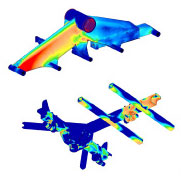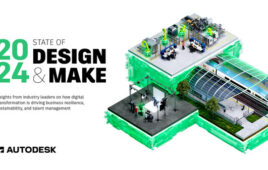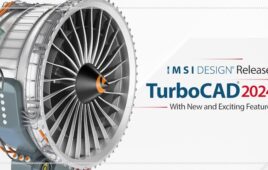Tucker Sno-Cat Corp. is the oldest successful manufacturer of motorized snow vehicles in the world.

Because Sno-Cats are operated in areas as harsh as the Antarctic, they must be extremely durable and reliable. Using Autodesk Algor Mechanical Simulation software for FEA and MES, Tucker simulates the motion of parts and validates the quality of their designs.
Images courtesy of Tucker Sno-Cat Corp.
Involved in the first motorized crossing of the Antarctic, Tucker also invented the four-track vehicle design, which features superior traction, stability, safety, and climbing ability.
Tucker designs digital prototypes of its vehicles with Autodesk Inventor and validates designs through finite element analysis (FEA) and mechanical event simulation (MES) using Algor Mechanical Simulation software. These sophisticated tools enable Tucker to perform complex simulations to assess the performance of designs in the harshest environments. With these design tools, Tucker has been able to:
• Produce fewer physical prototypes before manufacturing parts
• Reduce engineering change orders by 80%
• Use materials more efficiently, cutting waste and material costs
• Realize 50-60% cost savings by performing FEA and MES in-house
• Cut the product development cycle from as long as two years to six months
These design methods grew from a need to meet customer needs for custom vehicles more quickly. “A customer may want to change the deck size or mount a special plow blade or forklift attachment,” says Albert Allen, mechanical designer at Tucker. “To get the sale, we need to model how it will look and work in a few hours.”

Since bringing FEA in-house for analyzing components like these structural elements, Tucker saves up to 60% of cost and time for design validation.
One of the earliest adopters of Digital Prototyping, Tucker uses a single digital model throughout its product development process. Designers use Autodesk Inventor software to sketch concepts and create complete 3D models of their Sno-Cats. Electrical engineers refer to the model to determine requirements for the wiring systems they design. Engineers then validate the design using Algor Mechanical Simulation for FEA and MES. Finally, the company’s manufacturing vendors rely on the same digital model to produce parts exactly as designed.
Whether it’s used to tailor an existing vehicle or design an entirely new Sno-Cat, Autodesk software helps Tucker produce designs rapidly. Designers can easily reuse existing part designs, such as engines, steering columns, radiators, and axles. When they create new parts, designers work in an intuitive 3D environment-using functional tools that automate and speed up many routine design tasks.
The advantages of Digital Prototyping couldn’t be clearer for Tucker. It decreases the need for costly physical prototypes and reduces engineering change orders late in the development cycle. It also helps the company minimize material waste and avoid recreating designs from scratch every time there is a change.
Because Tucker vehicles are operated in areas as harsh as the Antarctic, they must be extremely durable and reliable. Using Mechanical Simulation software for FEA and MES, Tucker simulates the motion of parts and validates the quality of their designs-faster than ever before. For example, rather than outsourcing FEA on its roll-over protective structures, Tucker performs the analysis more efficiently and cost-effectively in-house.
Analysis and simulation time has also dropped drastically since Tucker started using Algor several years ago. “By bringing FEA and MES in-house, we’ve slashed both the time and cost for design validation by 50-60%,” concludes Allen. “The bottom line is that Autodesk supports our ability to innovate quickly and cost-effectively.”
Autodesk Inc.
www.Autodesk.com
::Design World::
Filed Under: Digital manufacturing, Software • FEA, Software • simulation, ENGINEERING SOFTWARE





Tell Us What You Think!